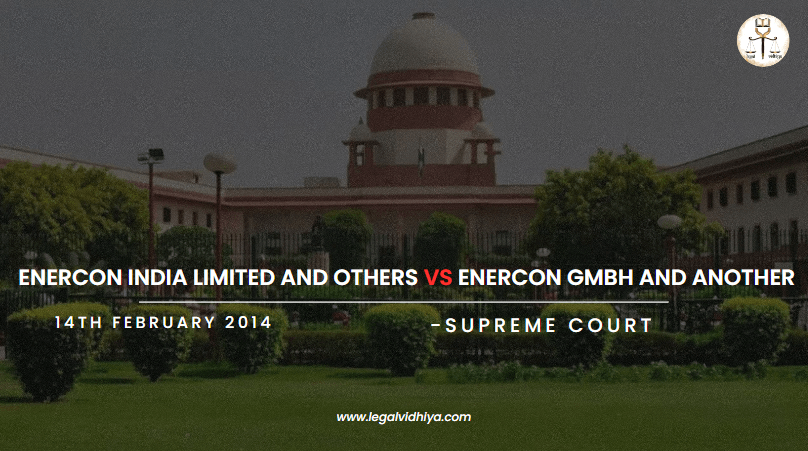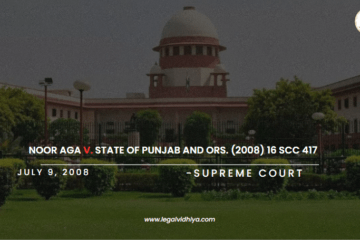
| CITATION | AIR 2014 Supreme Court 3152 |
| DATE OF JUDGMENT | 14TH February 2014 |
| COURT | Supreme Court |
| APPELLANT | Enercon (India) Ltd.&Ors |
| RESPONDENT | Enercon GNBH &ANR |
| BENCH | Fakkir Mohamad Ibrahim Kalifulla |
INTRODUCTION
This case emanates from the Bombay High Court’s October 5, 2012 judgment in CWP Nos.7804 of 2009 and 7636 of 2009, now subject to appeal. The dispute involves Appellants No.2 and 3, members of the Mehra family, and Respondent No.1, a German company, in a joint venture established in 1994 to form Enercon (India) Ltd. (EIL), tasked with manufacturing Wind Turbine Generators (WTGs) in India. The contractual foundation comprises several agreements, including the Share Holding Agreement, Technical Know-How Agreement, Supplementary Shareholding Agreements, and Supplementary Technical Know-How Agreement.
Central to the controversy is the Intellectual Property License Agreement (IPLA) executed on September 29, 2006. Appellants argue that the IPLA is not a concluded contract, asserting discrepancies with the prior Agreed Principles. Respondent No.1 contends the IPLA is binding, triggering a disagreement rooted in the interpretation of emails and letters exchanged between the parties.
The appeals seek resolution on the IPLA’s status, addressing whether it is a valid and concluded contract, with broader implications for the ongoing joint venture. The case underscores the intricacies of international joint ventures, contractual complexities, and the nuanced interpretation of agreements in the evolving landscape of wind energy technology collaboration.
FACTS OF THE CASE
- Appellants No.2 and 3, members of the Mehra family, along with Respondent No.1, a German company, established Enercon (India) Ltd. (EIL) in 1994. EIL, located in Daman, India, was formed to manufacture and sell Wind Turbine Generators (WTGs) in the country.
- On 12th January 1994, Appellants No.2 and 3 entered into a Share Holding Agreement (SHA) with Respondent No.1. The agreement stipulated that Respondent No.1 would hold 51% of EIL’s shares, while Appellants No.2 and 3 collectively would hold 49%.
- A Supplementary Technical Know-How Agreement (STKHA) was executed on 19th May 2000, amending a previous Technical Know-How Agreement. This agreement granted additional licenses for manufacturing specific models of WTGs.
- In April 2004, discussions about a potential future agreement covering evolving technologies led to a “Heads of Agreement” recorded on 23rd May 2006. On 29th September 2006, the Intellectual Property License Agreement (IPLA) was executed. However, a dispute arose regarding whether the IPLA was a concluded contract.
Legal battles ensued, including an interim order by the Bombay High Court in October 2007 directing the resumption of supplies by Respondent No.1. Disputes extended to arbitration proceedings, with the Appellants challenging the arbitration clause’s workability. The Daman Trial Court granted an anti-arbitration injunction, a decision upheld by the Daman Appellate Court. In response, Respondents initiated proceedings in the English High Court, resulting in complex cross-border legal entanglements and conflicting court orders.
ISSUES RAISED
- The appeals challenge the Bombay High Court’s order from October 5, 2012, which dismissed Civil Writ Petitions (CWP) Nos. 7804 and 7636 of 2009.
- On January 12, 1994, the parties entered into a Technical Know-How Agreement (TKHA), transferring technology rights for Wind Turbine Generators (WTGs). Supplementary Shareholding Agreements (SSHAs) amended the Share Holding Agreement (SHA), altering share distribution to 56% for Respondent No. 1 and 44% for Appellant Nos. 2 and 3.
- Disputes arose, leading to unilateral halts in supplies by Respondent No. 1 in 2007. Legal proceedings ensued, including a derivative suit, invocation of arbitration, and an Arbitration Claim Form seeking declaratory reliefs.
- The Daman Appellate Court set aside Daman Trial Court’s orders, leading to the filing of writ petitions. The Bombay High Court granted interim orders continuing status quo and stay on the reference under Section 45 of the Indian Arbitration Act.
- English High Court proceedings involved conflicting orders, including an anti-suit injunction. Key issues include the concluded contract’s validity, the workability of the arbitration agreement, determination of the seat of arbitration, and the entitlement to an anti-suit injunction.
CONTENTIONS OF APPEALENT
- Mr. Rohinton Nariman argues that there can be no arbitration agreement without a concluded contract. He asserts that the Intellectual Property License Agreement (IPLA) is not a concluded contract, pointing to discrepancies between the Agreed Principles and IPLA. The respondent acknowledges these differences, emphasizing that the IPLA was to be finalized to the satisfaction of all parties.
- The dispute includes a crucial debate on the seat of arbitration. Mr. Nariman contends that the seat should be in India, considering various factors such as the application of Indian laws, the location of relevant assets, and the choice of Indian arbitration law. This argument challenges the interpretation that London, mentioned as the venue, should be considered the seat.
- Dr. Abhishek Manu Singhvi argues that the arbitration clause is valid and workable. Despite the clause’s wording issues, he suggests that the missing element, the appointment of the third arbitrator, can be supplied by the court to make the arbitration clause functional.
- Dr. Singhvi asserts that the IPLA is final and intended to succeed the Know-How Agreement. He refers to the Heads of Agreement, indicating the parties’ good faith intentions and the governing law as German.
- Dr. Singhvi contends that the law of the seat dictates the curial law, emphasizing the importance of party intention in determining the seat. He argues that the proper law, law of arbitration, and curial law have been expressly mentioned in the present case, supporting the interpretation that London is the seat unless a contrary intention is expressed.
CONTENTIONS OF REPONDENT
- Non-Concluded Nature of IPLA:The Appellants argue that the Intellectual Property License Agreement (IPLA) is not a concluded contract.Correspondence, both prior and subsequent to the IPLA, is relied upon to demonstrate that no concluded contract exists.The term “final IPLA” in an email dated 24th November 2006 is highlighted as evidence of the ongoing nature of negotiations.
- Unworkability of IPLA and Arbitration Clause:Clause 12 of the IPLA, concerning its duration, is considered incapable of being performed.Mere signing of a document does not make it concluded if, in law, the contract is not concluded.The High Court’s interpretation of Clause 18.1 is challenged as misreading, suggesting an unworkable arbitration clause.
- Existence of Arbitration Agreement:The challenge to the existence of the substantive agreement, including the IPLA, is asserted to be a matter for the court’s determination under Section 45 of the Indian Arbitration Act, 1996.Reliance is placed on Chloro Controls (I) Pvt. Ltd. Vs. Severn Trent Water Purification Inc. & Ors.
- Elements of an Arbitration Agreement:Dr. Singhvi argues that an arbitration agreement is established through:Intention to arbitrate,Existence of a dispute,Existence of some legal relationship.
- Seat of Arbitration – India vs. London:Determining the seat is crucial, and Mr. Nariman argues for India based on various factors.Dr. Singhvi argues that surrounding circumstances indicate the parties intended to designate England as the seat.
JUDGEMENT
the court addressed key issues related to arbitration, emphasizing the limited scope of a Section 45 application to assess the arbitration agreement’s validity, not the entire contract. The doctrine of separability was invoked, highlighting the tribunal’s competence to decide on the Intellectual Property License Agreement’s (IPLA) validity, irrespective of the existence of a concluded contract. The court advocated for a pragmatic approach, ensuring workability of the arbitration clause within legal confines and upholding the overarching policy of minimal judicial intervention.
Crucially, the court clarified that London, chosen as a venue, did not constitute the seat of arbitration, designating India as the seat due to its closer connection. The decision underscored the inapplicability of English laws when all chosen laws were Indian. The judgment prioritized preserving the parties’ intent to arbitrate and maintaining the efficiency of arbitration proceedings, ultimately rejecting the notion of English courts having supervisory jurisdiction and affirming India as the appropriate seat of arbitration.
ANALYSIS
The presented case involves a dispute arising from the Agreed Principles, signed on September 29, 2006, governing the use and supply of windmill technology. Central to the contention is the arbitration clause, which triggers debates over jurisdiction, the seat of arbitration, and the applicable law. The appellants argue for the exclusive application of the Indian Arbitration Act, 1996, while the respondents advocate for London as the seat. The court grapples with the workability of the arbitration clause, emphasizing a pragmatic approach and citing jurisprudential principles to avoid frustrating the agreement. Notably, the Heads of Agreement, deemed final and binding, include an irrevocable acceptance of the arbitration agreement. The anti-suit injunction, initially imposed by the Bombay High Court and later modified by the English High Court, adds complexity to the proceedings. Furthermore, considerations of the business operations of the parties in Daman play a role in determining jurisdiction. The case underscores the nuanced interpretation of contractual agreements, particularly in the realm of international arbitration, requiring a careful balance between legal principles and the practicalities of ensuring fairness and enforceability.
CONCLUSION
The case presents a nuanced legal landscape involving arbitration, jurisdiction, and the interplay of Indian and English laws. The tribunal’s rejection of interpreting “venue” as “seat” underscores the centrality of the chosen Indian laws, dispelling any notion of applicability of English laws. The costs award, enforceable in the English Court, becomes a focal point of contention before the Delhi High Court under Section 34(2)(a)(iv) of the Arbitration Act, 1996. The court’s meticulous observations dismiss the defendant’s challenges, firmly establishing the exclusive applicability of Indian laws.
Addressing the issue of concurrent jurisdiction, the court foresees potential confusion and injustice if both Indian and English courts were to exercise jurisdiction simultaneously, highlighting the delicate balance required in such matters. The dismissal of the anti-suit injunction affirms the parties’ right to proceed to arbitration, emphasizing the significance of the chosen dispute resolution mechanism.
The conclusive part of the judgment upholds the Bombay High Court’s determination of the arbitration seat in India, rejecting the concurrent jurisdiction of English courts and setting aside the Daman Appellate Court’s decision on the anti-suit injunction. The restraint imposed on the respondents clarifies the legal landscape, affirming the primacy of the arbitration process and providing a definitive resolution to the intricate complexities of the case. The appointment of Lord Hoffmann as the third arbitrator further underscores the court’s proactive approach in ensuring a fair and expeditious resolution, considering the peculiarities and delays in the proceedings. Overall, the judgment navigates through the intricate web of arbitration and jurisdictional challenges, providing clarity and resolution to the parties involved.
REFERENCES
- SCC Online
- https://indiankanoon.org/doc/111538592/
This Article is written by Chhaya gaur student of Lloyd law college , Greater Noida (LLCGN); Intern at Legal Vidhiya.
Disclaimer: The materials provided herein are intended solely for informational purposes. Accessing or using the site or the materials does not establish an attorney-client relationship. The information presented on this site is not to be construed as legal or professional advice, and it should not be relied upon for such purposes or used as a substitute for advice from a licensed attorney in your state. Additionally, the viewpoint presented by the author is of a personal nature.




0 Comments